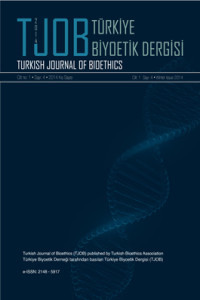Hekimlerin Tıbbi Müdahale Öncesinde Hastalardan Alınan Aydınlatılmış Onam Bilinci ve Uygulamaları
Bu makalede*, hekimlerin, aydınlatılmış onam alınmasında kullanılan formlar ile ilgili bilgi durumlarının belirlenmesi ve bu belirlemelere göre; hekimlere, tıp hukuku ve etiğine uygun onam almalarına katkı sağlayacak bilgiler verilmesi, öneriler sunulması amaçlanmıştır. Gereç ve Yöntem: Hekimlerin aydınlatılmış onam formunda yer alması gereken başlıklar (hastanın tanısı, girişimin zararları, riskleri, yararları, iyileşme süreci, başarı olasılığı gibi), aydınlatılmış onamın kim tarafından alınması gerektiği ile ilgili bilgi durumlarını belirlemek üzere anket oluşturulmuştur. Bu anket online ortamda hekimlere ulaştırılmıştır. Anket aracılığıyla elde edilen veriler SPSS programı kullanılarak analiz edilmiştir. Kişisel bilgilerin değerlendirilmesinde tanımlayıcı istatistiki analizler kullanılmıştır. Verilerin değerlendirilmesinde ise frekanslar ve yüzde dağılımlar alınmıştır. Analiz edilen veriler yasal düzenlemelere ve tıp etiğine uygunluk açısından değerlendirilmiştir. Bulgular: Ankete özel bir hastanede çalışan 139 hekim gönüllü olarak katılmıştır. Katılımcıların yaklaşık olarak %90’ı tanı ve girişim sonucu oluşan komplikasyonların, yaklaşık %85’i girişimin faydalarının ve iyileşme dönemi sorunlarının, yaklaşık olarak %75’i girişimin gerçekleştirilmemesinin sonuçlarının, yaklaşık %55’i başarı olasılığının aydınlatılmış onam formunda yer alması gerektiğini düşünmektedir. Onamın hekim tarafından alınması gerektiği ile ilgili maddeye katılımcı hekimlerin yaklaşık %85’inden fazlası katılma yönünde görüş bildirmiştir. Tartışma ve Sonuç: Aydınlatılmış onam formunda yer alması gereken bilgiler hakkında, hekimlerin, tıp hukukuna uygun görüş bildirmeleri olumlu bir durum olarak kabul edilebilir. Ancak, aydınlatılmış onam ile korunan hukuki değerler göz önüne alındığında, hekimlerin katılmama ve kararsızlık yönündeki görüşleri üzerinde durularak, katılmama ve kararsızlık yönündeki oranların azaltılması için önlemler alınması önerilmiştir.
Anahtar Kelimeler:
Aydınlatılmış onam, onam formu, hasta hakları, tıp hukuku, tıp etiği
Informed Consent Awareness and Practıces of the Physicians Before Medical Intervention
In this article, it was aimed to determine the knowledge status of physicians about the forms used in obtaining informed consent and according to these determinations; It is aimed to provide information and
suggestions to physicians that will contribute to obtaining consent in accordance with medical law and ethics. Material and Method: A questionnaire was created to determine the knowledge status of the physicians about the titles that should be included in the informed consent form (such as the diagnosis of the patient, the harms, risks, benefits of the intervention, healing process, probability of success), and who should receive informed consent. This questionnaire was delivered to physicians online. The data obtained through the questionnaire were analyzed using the SPSS program. Descriptive statistical analyzes were used in the evaluation of personal information. In the evaluation of the data, frequencies and percentage distributions were taken. The analyzed data were evaluated in terms of compliance with legal regulations and medical ethics. Results: 139 physicians working in a private hospital participated in the survey voluntarily. Approximately 90% of the participants think that the complications that occur as a result of the diagnosis and intervention, approximately 85% of the benefits of the intervention and the problems of the recovery period, about 75% of the consequences of not performing the intervention, about 55% of the probability of success should be included in the form of informed consent. . More than 85% of the participating physicians expressed their opinion to agree with the article about the necessity of obtaining consent by the physician. Discussion and Conclusion: It can be accepted as a positive situation that physicians express their opinions in accordance with medical law about the information that should be included in the informed consent form. However, considering the legal values protected by informed consent, it was suggested to take measures to reduce the rates of disagreement and indecision by
emphasizing the views of physicians on disagreement and indecision.
Keywords:
Informed consent, consent form, patient rights, medical law, medical ethics,
- ISSN: 2148-5917
- Yayın Aralığı: Yılda 4 Sayı
- Başlangıç: 2014
- Yayıncı: Türkiye Biyoetik Derneği
Sayıdaki Diğer Makaleler
Yapay Zeka Etiği Tartışmaları için Bazı Tarihsel-Kavramsal Önbilgiler
Kişilerin Sağlık Verilerini Paylaşmaya Zorlanması Bağlamında Medula Genelgesi
Hekimlerin Tıbbi Müdahale Öncesinde Hastalardan Alınan Aydınlatılmış Onam Bilinci ve Uygulamaları
Covid-19 Pandemisi ve Hekimlerin Hak Talepleri
Adli DNA Bankalarının İnsan Hakları Boyutuyla Değerlendirilmesi
